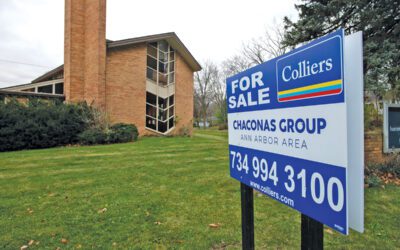
Megan Oxley first used ketamine as a sedative during her medical training in Detroit ERs. Now she uses it to treat depression at her own clinic, Michigan Progressive Health. | Photo: J. Adrian Wylie
The sign for Michigan Progressive Health on Washtenaw Ave. shows a smile superimposed on a chemical structure. It’s a drug called ketamine, and the clinic has been using it to treat people with severe depression since July 2020.
Physician Megan Oxley, the clinic’s cofounder and director, says that when its first location opened in Royal Oak in 2016, “there were like thirteen clinics in the country” offering ketamine for depression. And now? “They are estimating five hundred,” she says.
Ketamine’s popularity is surging because it can help patients whose depression hasn’t improved with standard antidepressants. In a small but rigorous 2016 study reported in the American Journal of Psychiatry, 69 percent of patients receiving ketamine by infusion into the bloodstream had their scores, on a standard depression diagnostic tool, cut in half in two weeks. Many were in remission, with no clinical depression.
The U-M Depression Center opened a ketamine clinic last year. U-M psychiatrist Sagar Parikh, the center’s associate director, predicts that “ketamine is going to get more popular, because it really does work, and it’s fast.”
—
Ketamine is a Michigan product, with the U-M a central player. It’s a cousin of PCP, an anesthetic first synthesized by chemists at Detroit drug company Parke-Davis in 1956. The FDA approved it as a general anesthetic in 1963, but Parke-Davis quickly pulled it from the market because of severe and prolonged post-surgery delirium.
Some people like that effect—PCP is now best known as the street drug “angel dust”—but Parke-Davis was already modifying its chemistry to make it safer. Wayne State chemist Calvin Stevens, a Parke-Davis consultant, succeeded in 1962.
“Compound CI-581” proved to be an excellent anesthetic in animal tests, so Parke-Davis enlisted U-M pharmacologist Ed Domino to conduct a human study at Jackson Prison. (A human ethics committee, including U-M faculty, oversaw the trial.) The drug proved to be remarkably safe, though many prisoners, emerging from anesthesia, briefly experienced PCP-like symptoms. Domino died last year, but when U-M postdoc Nicholas Denomme interviewed him for a 2018 paper, he recalled comments like this one: “‘Jesus, I’m in outer space. My God, I don’t have any arms or legs. I’m floating, man what a high! Oh my God!’”
Renamed ketamine, the drug was approved as a general anesthetic in 1970. Domino’s wife Toni proposed the term “dissociative” to describe the drug’s strange sensory effects, and the term stuck.
Dissociation mostly kept ketamine out of hospital surgical suites, but it became the drug of choice for emergency anesthesia, because the risk of accidental death, even at high doses, is minuscule. At roughly a tenth of the anesthetic dose, it’s also used as a sedative and painkiller in emergency rooms around the world.
Oxley first used ketamine during her training in emergency rooms in Detroit. It’s often used, she says, to “sedate somebody to maybe put their arm back in place, or to sew up like a two-year-old who has a big laceration on their face.”
But unlike other sedatives, Oxley says, with ketamine her patients “would have an ‘experience.’” They told her things like, “‘I was in the Matrix.’”
Fascinated, she read about its effects, including its use for depression. The first clinical trial was in 2000, but it took many years to win over the skeptics. Even when Oxley and partner Ryan Boyle founded Michigan Progressive Health, there were few standards on how to administer ketamine for depression.
Today there are two widely used protocols. One is intravenous (IV) infusions, twice a week for three to four weeks, and—if it works—a less frequent dose after that. The other is to take Spravato, a slightly different version of ketamine, by nasal spray.
The FDA approved Spravato for treatment-resistant depression in 2019. No drug company will do the trials necessary for FDA approval of IV ketamine for depression, because the drug long ago lost its patent protection—but there’s no doubt it works.
—
Michigan Progressive Health has a distinct New Age feel, with decorative driftwood, stones, and pinecones scattered around the waiting room, and lava lamps and candles in the consultation rooms. Oxley herself has a somewhat mystical view of ketamine as a portal into a new, healthier state of mind. “It’s a very Western medical procedure,” she says. “But patients are having these very big kind of Eastern-medicine experiences … collective consciousness and meeting with God and being in the stars, and all of these things we can’t understand.”
Many of her patients receive “ketamine-assisted psychotherapy” right after treatment. Oxley says the drug opens them to a self-acceptance that therapists can reinforce. “Ketamine has this power to stop the nerve transmission for a period of time,” she explains. “When it restarts back up … instead of being, like, hyper-focused on a memory, or hyper-focused on a certain fear, or hyper-focused on your ego, there’s more cohesion between all the different parts of that default mode network that kind of govern our mood and self-image.”
Because IV treatment isn’t FDA-approved, insurance companies don’t cover the cost: Patients pay out of pocket, typically at $500 per infusion. Most receive eight infusions, starting at twice a week, for “initiation,” and average one booster every four to six weeks after that. The cost quickly adds up.
Asked why she doesn’t offer Spravato, Oxley mentions that insurance coverage is often conditional on also taking antidepressant pills, and that’s anathema to much of her clientele. “People come to me because they don’t want to be on meds,” she says. “They don’t like the way the medications feel. And so a traditional psychiatry office might have a very different answer.”
The three other Ann Arbor clinics, all with psychiatrists on staff, take a more conventional approach. Parikh, a Canadian-trained psychiatrist, began giving liquid ketamine, by mouth, to people with treatment-resistant depression in Canada in 2012.
His early patients “were in pretty bad shape,” he says. After giving ketamine, “the thing that surprised me is that a number of them said, ‘I’ve started to feel a bit better, but you know what? I don’t think about death anymore.’” The drug’s ability to relieve suicidal thoughts impressed Parikh. “This is a person with a lethal condition,” he stresses. “They’re at high risk of death.”
The lifesaving effects of IV ketamine can be even faster and more dramatic, and that’s what U-M offers—but only for patients with treatment-resistant depression, by referral. “Unfortunately, it’s a self-paid procedure at this stage, although we’re negotiating with insurers,” Parikh says. “We think it will be an insured service within a year, at least by some insurance companies.”
Ketamine treatments are safe—“Virtually no one has problems,” Parikh says—but each person reacts differently.
Most experience a mild intoxication, “similar to what you might have with alcohol,” Parikh says. At most a quarter of U-M’s patients will briefly “dissociate” during the forty-minute infusion, and about the same number experience nausea. Ketamine can also cause a spike in blood pressure, so all Ann Arbor’s clinics monitor for that.
Ketamine works on the brain in multiple ways, including making new neural connections almost immediately, animal studies show. The drug also dampens some excess neurotransmission and boosts the brain’s natural opioid responses. But there’s no single explanation for its dramatic effects. “It’s probably like a curry,” Parikh says. “The best parts of a curry are not any one spice, it’s the cumulative effects of several spices.”
Unlike Michigan Progressive Health, the U-M does not offer ketamine-assisted psychotherapy. “It’s a controversial topic,” Parikh emails. “People are claiming to do that, but it hasn’t really been well defined nor is there any research evaluating it.”
And while Oxley says she would never suggest transitioning from ketamine to a traditional antidepressant, Parikh does so often. He tells patients this: “‘Ketamine may have gotten you out of the pit, and now the standard medicines, which might not have been strong enough to get you out of the pit, they could be strong enough to keep you well.’”
—

At Michigan Advanced Psychiatry, Andrew Schmale offers Spravato, the nasal spray version of ketamine. Because it’s covered by insurance, he says, “it’s going to cost people far, far less.” Photo: J. Adrian Wylie
Michigan Advanced Psychiatry, in the McKinley building on N. Main, is a private ketamine clinic with strong U-M connections. Owner Andrew Schmale launched it in 2020, straight out of his U-M psychiatry residency. Two other young U-M-trained psychiatrists work there. Schmale, wearing a U-M Radrick Farms pullover (he’s an avid golfer) and yellow sneakers, explains that the U-M trained them all in techniques that fundamentally change brain structure and function: transcranial magnetic stimulation (TMS), electroconvulsive therapy (ECT), and ketamine. (All local ketamine clinics also offer TMS—which uses magnetic fields to stimulate brain neurons—to treat depression.)
Unlike Michigan Progressive Health and the U-M, Michigan Advanced Psychiatry offers Spravato, the nasal spray version of ketamine. Because Spravato is covered by insurance, “it’s going to cost people far, far less,” Schmale says. But Spravato takes longer to kick in than IV ketamine. “It’s more like a lower and slower buildup effect,” says Schmale. Some of Schmale’s patients eventually switch to IV ketamine, and a few prefer to start that way, but Spravato is standard. Schmale says that 50 to 60 percent of patients with treatment-resistant depression respond to it.
Spravato and insurance coverage may partly account for Michigan Advanced Psychiatry’s popularity: Business manager Dane Reinhart says the clinic books 130–150 appointments a week, which includes TMS patients. In contrast, the U-M’s clinic treats two to four ketamine patients a day just two days a week.
And unlike the U-M, Michigan Advanced Psychiatry offers ketamine-assisted psychotherapy, although with less fervor than Michigan Progressive Health, which lists five therapists on its website. Instead, a single clinical psychologist works part-time with motivated patients. Schmale stresses that psychotherapy success does not depend on experiencing dissociation, which psychiatry considers a ketamine side effect—a bug, not a feature. But following treatment, while still in the office, patients “are still in a place of warmth and empathy… that lends itself to therapy in that time period,” says Schmale. “Where they may be able to talk about things they otherwise wouldn’t.”
One of Schmale’s U-M mentors was psychiatrist Avinash Hosanagar, who runs the ketamine clinic at the Ann Arbor VA Hospital. Launched in 2019, it’s the only VA ketamine clinic in Michigan, and it draws patients from as far away as Dayton, Ohio. The clinic’s ketamine protocol is the reverse of Schmale’s: All patients start with IV ketamine, and then—if it works—they switch to Spravato. (Reasons for this have to do with the VA system’s processes and costs.) Hosanagar says his response rate is almost 70 percent, with more than half of those achieving “remission”—dropping below the depression threshold on a standard rating scale.
“Many of our patients talk about having a severe depression that completely paralyzes them,” Hosanagar says. “After this treatment, when they do respond, patients talk about something [that] has changed, remarkably. People have the energy to do things. They feel brighter.”
—

U-M psychiatrist Sagar Parikh was impressed when he first prescribed ketamine to people
with treatment-resistant depression in 2012. “A number of them said, ‘I’ve started to feel
a bit better, but you know what? I don’t think about death anymore. ’” Photo: J. Adrian Wylie
Ketamine is far from a perfect drug, Hosanagar stresses. Most patients are able to manage the disassociative effects, he says, but “for others it’s very anxiety-provoking, distressing, in their first treatment.” And it may not be safe for people with a history of seizure disorders, psychosis, or uncontrolled hypertension.
In much higher doses, ketamine is also abused as a street drug. Ray Dalton, clinical director for addiction recovery program Dawn Farm, says he sees people for whom it’s “their substance use of choice.”
Ketamine addiction is uncommon, but because the drug activates the brain’s reward centers, “it could lead to a lapse back into substance use” for people who’ve had drug or alcohol problems, Dalton says. Medical literature also reports urinary, cognitive, and mental problems in long-term recreational users. (Parikh says in his own research, people who take much smaller doses for depression actually have improved cognition.)
None of the four Ann Arbor ketamine clinics treats people who’ve been addicted to ketamine or who have an ongoing substance abuse problem. “We do treat patients who have a history of substance use disorder, as long as their substance use disorder is controlled at the time of receiving ketamine,” says Hosanagar. “For many, their depression may be driving their addiction. And treating that, and helping with that, is going to be an important part of their overall recovery process.”
—
Oxley says she has given over 3,000 ketamine infusions at her clinics. But, sixty years after Calvin Stevens first synthesized it, the drug retains an aura of mystery. “There’s so much about this medication, and this treatment, and psychiatry that we don’t know,” Oxley says. “And we really have to come to this place of humility, where we work together: ‘Here’s what we think we know, here’s where you’re at, we’re going to work together, and we’re going to try this out.’”



